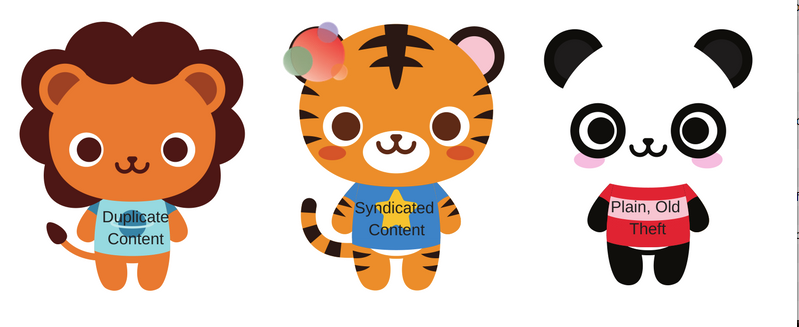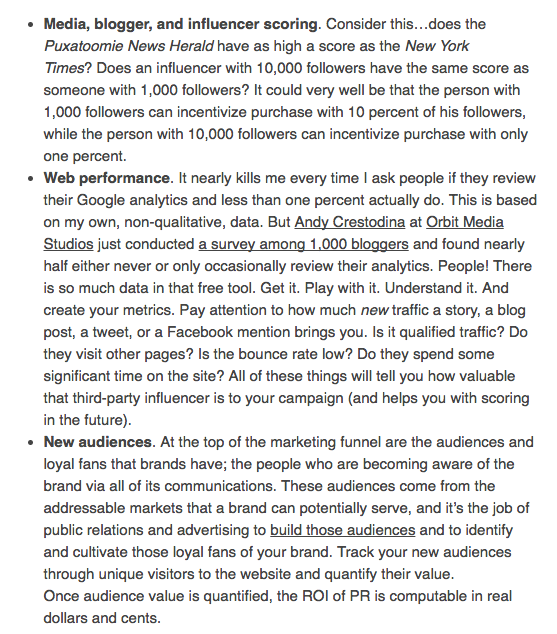 In the PR Dream Team yesterday, we had a conversation about duplicate content.
In the PR Dream Team yesterday, we had a conversation about duplicate content.
A member has a client that distributes their product internationally and they want all of the distributor’s websites to look the same.
Right now, everyone uses their own designs.
Not good, from a branding perspective.
They have only one distributor per country, which makes it fairly easy to manage.
So the question was posed:
If we set up websites for distributors and copy the content of the main site, making modifications to fit the new location, will that hurt us with Google rankings?
The longer answer is…it depends.
There are lots of ways you can achieve the same goal without having the same content on multiple URLs.
Let’s look at duplicate content, syndicated content, and plain old theft…and figure out how our PR Dream Team member might help her client.
Duplicate Content
According to Moz (my go-to for all things SEO), duplicate content is:
Content that appears on the internet in more than one place. That “one place” is defined as a location with a unique website address—so, if the same content appears at more than one web address, you have duplicate content.
So, let’s say the client has distribution in 75 countries.
If they do set up websites for the distributors and copy the content of the main site, they’d have duplicate content in 74 countries.
While Google won’t blacklist the sites, they’ll only return results for one of the websites—the one they’d deem most important.
So, say the U.S. website has a domain authority of 62 and the other countries have scores between 26 and 43.
Google would always return the U.S. site in search results, likely in other parts of the world, because it’s deemed the most relevant—and certainly the most authoritative.
They could bring all of the sites under one URL and have a distributor locator on the site.
That’s likely not the best idea, simply because their distributors probably sell more than their product.
They won’t want traffic to leave them to go to the central location.
Ideally, our PR Dream Team member would recommend they create unique content for all 75 websites.
That solves the branding issue, they’re able to better control the messaging, and they’ll show up in organic search.
Syndicated Content
All of us who have ever worked with a client already know what happens next.
When our friend recommends her client create unique content for all 75 sites, they balk…either at the time required or the cost.
And, let’s be real, trying to say the same thing 75 times is not some small undertaking.
Instead, they could syndicate the content from the U.S. site.
Here is how that would work:
- They would still need to create unique content for each of the home pages—to reflect location and cultural differences.
- On every subsequent page, the content—with modifications for location—could include a canonical link to the U.S. site.
This is what it looks like in the Yoast plugin on your WordPress site.
If you click the little wheel icon on the left-hand side, you’ll get what you see above.
At the bottom, you see “canonical URL.”
In there, our PR Dream Team member could add the URL to the same page on the U.S. site.
This tells Google that the content came from the U.S. site and the local country is syndicating it.
The challenge with this, of course, is Google could return the U.S. site in search results, instead of the local one.
And then we’re back to needing a distributor locator on the U.S. site.
It’s also really irritating when you write content for your site, it’s syndicated, and people share that instead of the original.
But that doesn’t really help the issue here. I’m just venting.
Plain, Old Theft
Then you have the issue of plain, old theft.
Here is a really great example.
I wrote a blog post in 2014 about the types of things you should measure in a PESO model communications program.
Earlier this week, a blog post ran on another site that looked eerily familiar.
Here is one example of what was written on the other site:
The first bullet point is word-for-word, while the other two are summaries.
This is duplicate content at its finest—and it’s theft.
Nowhere is there a canonical link on this site.
It doesn’t say, “A version of this first appeared on Spin Sucks,” with a link to the original.
Which means it’s also not syndicated content.
It’s theft.
So in the example of the PR Dream Team member’s client wanting to provide websites for all of its distributors, the same content could look like theft.
Some well-meaning website visitor could see another country’s website, analyze the content, and decide it was stolen.
Then they could either alert the owner of the U.S. site (the best outcome) or they could do a DMCA complaint themselves.
This could result in Google removing the page(s) entirely or blacklisting the site so it never shows up in search results.
The Duplicate Content Moral of the Story
The moral of the story is the best way to handle this is to create unique content for all 75 sites.
If that’s not doable, there are other options, but be cautious that you’re not going to be accused of stealing content.
If the site were a blog, I’d recommend syndicating all day long (with about 20 percent original content thrown in).
But, because it’s a website that sells a product, not a content-driven site, that’s likely not the best option, either.
The point is, you can get around the duplicate content issue with some elbow grease and brainstorming.
It might not be easy, but it’ll be worth it in the long run.
If you have other ideas for our PR Dream Team member, let’s hear ’em!

